Basic Rifle Maintenance - Part 2
By Vince Bottomley
©Copyright, Target Shooter Magazine
Last month, in part one, we had a look at the bolt and what we could do to keep it in tip-top condition. This month, I had intended to look at the receiver but we had a request to cover barrel-cleaning – which I had intended to do the month after – so, always happy to oblige, we'll swap things around.
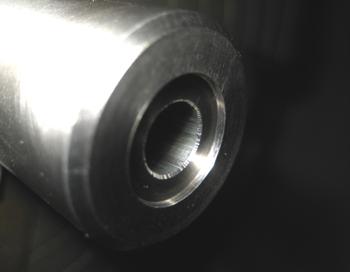
If your crown looks like this you should maybe visit your gunsmith.
OK, barrels. Whereas we could strip our bolt into its component parts and inspect, clean and lube as necessary, there's not a lot we can do to a barrel, except clean it. Removal is not really an option and anyway, what would it achieve?
Like most of you, I've been cleaning barrels for a good number of years but, I have to admit, until I bought a borescope, I didn't really know what I was doing. I should perhaps qualify that and say – I couldn't SEE what I was doing. The borescope made me revise my cleaning regime!
We all have our favourite bore cleaners and mine is Butch's Bore Shine. I'd never used Butch's until I went to New Zealand for the World Benchrest Championships in 2001. It's customary at these events to receive a 'goody-bag' and ours contained a bottle of Butch's. Naturally, my rifle was squeaky-clean but, why not give the Butch's a go and see if it will bring out any more fouling? I was shocked to find that it did - lots! My next step was to take my bottle of bore-cleaner – which I had cunningly smuggled on the plane in a shampoo bottle – and pour it down the drain!
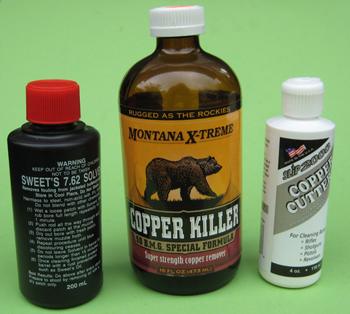
There are plenty of copper-solvents on the market but Sweets is as good as any.
There are other bore cleaners – like Hoppes, Shooters Choice, Pro-Shot etc. and if I find one better than Butch's, I'll switch. Some bore cleaners can get the barrel almost too clean and dry, so I like to 'cut' my Butch's with a dash of Kroil – no more than 10%.

I recently read a piece on barrel cleaning in a well known publication where it talked about 4x2 and Young's 303 gun-oil. If these items are still part of your cleaning kit, maybe now's the time to get up to date. There is an excellent family-owned American company called Pro-Shot. Tim Hannam at Leeds is the UK importer.
Get yourself some Pro Shot brass spear-point jags, correct size patches and Pro Shot bronze brushes. These brushes by the way are not meant to be used for years like those horrendous Parker Hale things with a steel core. The Pro Shot brushes are brass-cored and quite cheap and you should throw it away as soon as you see any signs of the bristles breaking off. And don't forget - ALWAYS USE A BORE-GUIDE!
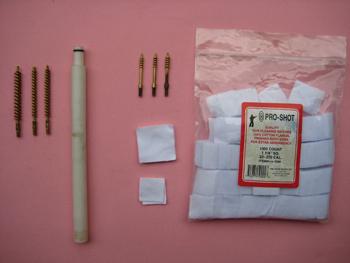
Brushes, jags and patches from Pro Shot – and don't forget the bore-guide.
Money-saving tip - most of us have more than one rifle calibre to clean – guys, you can clean everything with a 22 rod – no need to buy more than one cleaning rod! I even use just one 22 jag – fold your patches in half or use two patches and you can clean a 308 with a 22 jag!
First off, I know that no one likes cleaning their rifles. I don't like cleaning my rifles but I do know that a rifle with a badly fouled barrel will not deliver best accuracy. But how do we assess when a barrel needs cleaning? To measure the accuracy fall-off you would need to set up your rifle benchrest style, to eliminate as far as possible any human errors and shoot several groups and watch the groups open-up as the round-count increases. But you don't actually need to do it because thousands of benchrest shooters have already done it.
Two points to note – the more accurate your rifle, the sooner fouling will be detrimental to accuracy and, smaller calibres seem to suffer from the effects of fouling more than larger calibres. My 6PPC benchgun will run to about 25 rounds before accuracy noticeably deteriorates. With my 308 F/TR rifle, it's maybe double that figure. Both rifles use BAT actions and Bartlein barrels.
The golden rule is – clean your rifle as often as you can - if you want it to deliver best accuracy. In other words, clean after every competition at the end of the day. If your round-count is exceptionally high, clean during the competition – if you get the chance. Remember however, some rifles will need a shot or two to settle down after cleaning and you should know how many shots your rifle needs from a clean barrel before it shoots 'point of aim'.
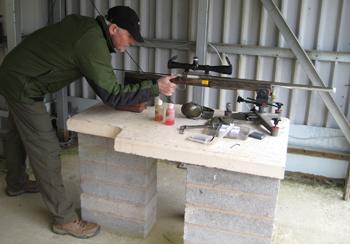
Nobody likes cleaning but it's got to be done and done properly to maintain accuracy.
Everyone will have their own cleaning regime but hopefully it will follow roughly similar lines. At the end of a day's shooting, here's my routine:
1. Pass a couple of loose-fitting patches soaked in your favourite cleaning fluid through the bore. This will push out the loose powder residue.
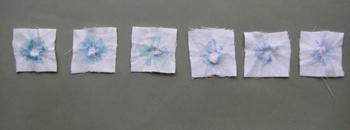
These patches came out of a 308 after 25 rounds – and it still isn't copper-free!
2. Scrub the bore with a bronze bore-brush wetted with cleaning fluid – I use one pass for every round fired as a rough guide. Please do not attempt to reverse the brush in the bore – take it straight out of the muzzle but be careful when you pull it back through the crown – it's very easy to damage the crown when cleaning. A bronze brush will not damage your bore and most benchrest shooters will scrub with a bronze brush every 10 to 15 rounds. That equates to five or six cleans in a single day.
3. Next, pass two or three tight-fitting dry patches through the bore to push out the fouling loosened by the brushing.
4. Finish off with a loose wet patches followed by a tight dry patches until they come out clean. Finish with a couple of dry patches so the bore is completely dry. Completely dry? Don't forget, we 'cut' our Butch's with 10% Kroil which prevents that 'squeaky-clean' effect.
5. Is there any copper in the bore? Almost certainly! Pass a loose-fitting patch through the bore loaded with a good copper solvent – Sweets is as good as anything. Many bore cleaners claim to remove copper – Butch's does but it is nowhere near as effective as Sweets. I also like Montana Extreme Copper Killer and Pro shot Copper Remover. Most copper solvents are ammonia based. The ones that work well will bring tears to your eyes if you take a tiny sniff! If you are allergic to ammonia try the Pro-Shot, it's almost odourless. Sweets is not always easy to get but Fultons at Bisley usually have it.

6. Let the copper solvent do its work by leaving it in the bore for at least ten minutes. Ignore any fables about Sweets damaging your bore. After 10 or 15 minutes, push out the Sweets with a tight-fitting dry patch. Any blue streaks on it? Yes? Repeat until the blue disappears.
7. Copper solvents can leave a slightly sticky coating in the bore so we need to clean it off with the wet patch/dry patch routine as in step 4.
8. If you have a stainless-steel barrel, consider it job done. If you have a chrome-moly barrel and you use the rifle regularly and store it indoors – job done. If the rifle is likely to be left for some time or stored in a damp atmosphere, then a patch sprayed with WD40 and passed through the barrel will afford the necessary protection but you MUST patch-out before you shoot. Incidentally, the stainless-steel used in rifle barrels is not a true stainless and it will also rust if left for any length of time in a damp atmosphere.
After cleaning, I often have a look at the bore through the borescope – particularly if the rifle doesn't seem to be performing to its expected standard. Copper is often still in there even though the patches aren't turning blue. A more aggressive strategy is called for.
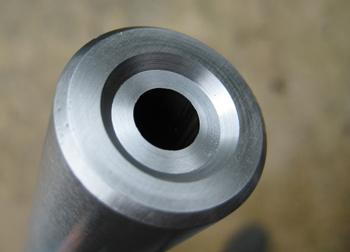
A clean, sharp crown is the ideal.
You can make the copper solvent more 'active' by scrubbing the bore with a bristle brush soaked in the solvent – don't use a bronze brush for obvious reasons! The scrubbing action will induce oxygen into the solvent which acts as a catalyst and makes the solution work better. Copper solvents need oxygen to work. If you drop a bullet into your bottle of copper solvent, it will still be bright copper coloured after a week but if you put a drop of solvent on a bullet, it will turn blue in minutes.
As a last resort, you can 'JB' your barrel. JB is a specially prepared bore paste for removing stubborn fouling. It's popular with benchrest shooters as it can bring a barrel that has 'gone off' back to life.
It's quite simple to use. Prepare a very tight-fitting patch which really takes some effort to push through the bore. You can do this by thickening a standard patch with a small square or two of kitchen roll under it. Now smear the JB paste on the patch and rod the bore vigorously! It's best to 'short-stroke' it by doing eight or nine inches at a time. You've really got to work that rod and change patches frequently. The patches will come out jet-black. After JB-ing, clean thoroughly as steps 1 to 4 above.
JB doesn't always perform miracles but if your rifle has lost its edge, it's worth a go. JB is a once a year thing – not every week!
We haven't mentioned those aerosol cleaners yet like Forrest Bore Foam and Wipe-out. On the face of it they are the simple answer to all that scrubbing and patching. Unfortunately, the foam needs to be left in the bore for a long time - maybe eight hours or overnight - to do its job. Even then, how do you know your rifle is clean? Repeat the process? Who can spend hours on what is really just a five-minute job?
Is there any other barrel maintenance we can do now that it's clean? Well, if you know someone with a borescope, beg borrow or steal a look at your bore. Borescopes cost a few hundred pounds but maybe your club could afford one and charge members £5 a go. In fact, once members have used it, I predict much return business!

Finally, it's often said that the most important part of a barrel is the last inch. Have a good look at your crown through a magnifier. There are many different ways to crown a barrel but every crown should be free from burrs or dings and should be evenly cut. The lands should be clearly visible and undamaged. If you suspect the crown is anything other than perfect, go along to your favourite gunsmith and ask him to re-cut it.
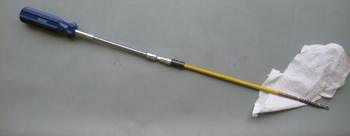
A home-made chamber cleaning tool.
Before we close this article on barrels, don't forget the chamber – particularly the chamber-neck -which will soot-up in exactly the same way as the cartridge-case neck. All gunshops sell cleaning-rods but next time you go in your local shop ask for a chamber cleaning tool. You will likely be met with a blank stare – but why? Cleaning the chamber is important. An old pistol cleaning rod fitted with a bronze brush will do the job (see pic). Wrap a turn of kitchen roll around the brush, apply a few drops of cleaning fluid and clean out that chamber! Dry it afterwards and pass a patch through the bore to ensure that no fragments of kitchen roll are lurking in there.
Next month, we will take a look at the stock.
Target Shooter is the first UK online shooting magazine and best of all it is free! The magazine is aimed at all target shooters, or 'paper punchers', that enjoy to read about their sports, reviews, product information, firearms, competitions, club information, etc, etc. Remember the name Target Shooter, as it is a magazine produced by shooters for shooters.
By Vince Bottomley
©Copyright, Target Shooter Magazine
Last month, in part one, we had a look at the bolt and what we could do to keep it in tip-top condition. This month, I had intended to look at the receiver but we had a request to cover barrel-cleaning – which I had intended to do the month after – so, always happy to oblige, we'll swap things around.

If your crown looks like this you should maybe visit your gunsmith.
OK, barrels. Whereas we could strip our bolt into its component parts and inspect, clean and lube as necessary, there's not a lot we can do to a barrel, except clean it. Removal is not really an option and anyway, what would it achieve?
Like most of you, I've been cleaning barrels for a good number of years but, I have to admit, until I bought a borescope, I didn't really know what I was doing. I should perhaps qualify that and say – I couldn't SEE what I was doing. The borescope made me revise my cleaning regime!
We all have our favourite bore cleaners and mine is Butch's Bore Shine. I'd never used Butch's until I went to New Zealand for the World Benchrest Championships in 2001. It's customary at these events to receive a 'goody-bag' and ours contained a bottle of Butch's. Naturally, my rifle was squeaky-clean but, why not give the Butch's a go and see if it will bring out any more fouling? I was shocked to find that it did - lots! My next step was to take my bottle of bore-cleaner – which I had cunningly smuggled on the plane in a shampoo bottle – and pour it down the drain!

There are plenty of copper-solvents on the market but Sweets is as good as any.
There are other bore cleaners – like Hoppes, Shooters Choice, Pro-Shot etc. and if I find one better than Butch's, I'll switch. Some bore cleaners can get the barrel almost too clean and dry, so I like to 'cut' my Butch's with a dash of Kroil – no more than 10%.

I recently read a piece on barrel cleaning in a well known publication where it talked about 4x2 and Young's 303 gun-oil. If these items are still part of your cleaning kit, maybe now's the time to get up to date. There is an excellent family-owned American company called Pro-Shot. Tim Hannam at Leeds is the UK importer.
Get yourself some Pro Shot brass spear-point jags, correct size patches and Pro Shot bronze brushes. These brushes by the way are not meant to be used for years like those horrendous Parker Hale things with a steel core. The Pro Shot brushes are brass-cored and quite cheap and you should throw it away as soon as you see any signs of the bristles breaking off. And don't forget - ALWAYS USE A BORE-GUIDE!

Brushes, jags and patches from Pro Shot – and don't forget the bore-guide.
Money-saving tip - most of us have more than one rifle calibre to clean – guys, you can clean everything with a 22 rod – no need to buy more than one cleaning rod! I even use just one 22 jag – fold your patches in half or use two patches and you can clean a 308 with a 22 jag!
First off, I know that no one likes cleaning their rifles. I don't like cleaning my rifles but I do know that a rifle with a badly fouled barrel will not deliver best accuracy. But how do we assess when a barrel needs cleaning? To measure the accuracy fall-off you would need to set up your rifle benchrest style, to eliminate as far as possible any human errors and shoot several groups and watch the groups open-up as the round-count increases. But you don't actually need to do it because thousands of benchrest shooters have already done it.
Two points to note – the more accurate your rifle, the sooner fouling will be detrimental to accuracy and, smaller calibres seem to suffer from the effects of fouling more than larger calibres. My 6PPC benchgun will run to about 25 rounds before accuracy noticeably deteriorates. With my 308 F/TR rifle, it's maybe double that figure. Both rifles use BAT actions and Bartlein barrels.
The golden rule is – clean your rifle as often as you can - if you want it to deliver best accuracy. In other words, clean after every competition at the end of the day. If your round-count is exceptionally high, clean during the competition – if you get the chance. Remember however, some rifles will need a shot or two to settle down after cleaning and you should know how many shots your rifle needs from a clean barrel before it shoots 'point of aim'.

Nobody likes cleaning but it's got to be done and done properly to maintain accuracy.
Everyone will have their own cleaning regime but hopefully it will follow roughly similar lines. At the end of a day's shooting, here's my routine:
1. Pass a couple of loose-fitting patches soaked in your favourite cleaning fluid through the bore. This will push out the loose powder residue.

These patches came out of a 308 after 25 rounds – and it still isn't copper-free!
2. Scrub the bore with a bronze bore-brush wetted with cleaning fluid – I use one pass for every round fired as a rough guide. Please do not attempt to reverse the brush in the bore – take it straight out of the muzzle but be careful when you pull it back through the crown – it's very easy to damage the crown when cleaning. A bronze brush will not damage your bore and most benchrest shooters will scrub with a bronze brush every 10 to 15 rounds. That equates to five or six cleans in a single day.
3. Next, pass two or three tight-fitting dry patches through the bore to push out the fouling loosened by the brushing.
4. Finish off with a loose wet patches followed by a tight dry patches until they come out clean. Finish with a couple of dry patches so the bore is completely dry. Completely dry? Don't forget, we 'cut' our Butch's with 10% Kroil which prevents that 'squeaky-clean' effect.
5. Is there any copper in the bore? Almost certainly! Pass a loose-fitting patch through the bore loaded with a good copper solvent – Sweets is as good as anything. Many bore cleaners claim to remove copper – Butch's does but it is nowhere near as effective as Sweets. I also like Montana Extreme Copper Killer and Pro shot Copper Remover. Most copper solvents are ammonia based. The ones that work well will bring tears to your eyes if you take a tiny sniff! If you are allergic to ammonia try the Pro-Shot, it's almost odourless. Sweets is not always easy to get but Fultons at Bisley usually have it.

6. Let the copper solvent do its work by leaving it in the bore for at least ten minutes. Ignore any fables about Sweets damaging your bore. After 10 or 15 minutes, push out the Sweets with a tight-fitting dry patch. Any blue streaks on it? Yes? Repeat until the blue disappears.
7. Copper solvents can leave a slightly sticky coating in the bore so we need to clean it off with the wet patch/dry patch routine as in step 4.
8. If you have a stainless-steel barrel, consider it job done. If you have a chrome-moly barrel and you use the rifle regularly and store it indoors – job done. If the rifle is likely to be left for some time or stored in a damp atmosphere, then a patch sprayed with WD40 and passed through the barrel will afford the necessary protection but you MUST patch-out before you shoot. Incidentally, the stainless-steel used in rifle barrels is not a true stainless and it will also rust if left for any length of time in a damp atmosphere.
After cleaning, I often have a look at the bore through the borescope – particularly if the rifle doesn't seem to be performing to its expected standard. Copper is often still in there even though the patches aren't turning blue. A more aggressive strategy is called for.

A clean, sharp crown is the ideal.
You can make the copper solvent more 'active' by scrubbing the bore with a bristle brush soaked in the solvent – don't use a bronze brush for obvious reasons! The scrubbing action will induce oxygen into the solvent which acts as a catalyst and makes the solution work better. Copper solvents need oxygen to work. If you drop a bullet into your bottle of copper solvent, it will still be bright copper coloured after a week but if you put a drop of solvent on a bullet, it will turn blue in minutes.
As a last resort, you can 'JB' your barrel. JB is a specially prepared bore paste for removing stubborn fouling. It's popular with benchrest shooters as it can bring a barrel that has 'gone off' back to life.
It's quite simple to use. Prepare a very tight-fitting patch which really takes some effort to push through the bore. You can do this by thickening a standard patch with a small square or two of kitchen roll under it. Now smear the JB paste on the patch and rod the bore vigorously! It's best to 'short-stroke' it by doing eight or nine inches at a time. You've really got to work that rod and change patches frequently. The patches will come out jet-black. After JB-ing, clean thoroughly as steps 1 to 4 above.
JB doesn't always perform miracles but if your rifle has lost its edge, it's worth a go. JB is a once a year thing – not every week!
We haven't mentioned those aerosol cleaners yet like Forrest Bore Foam and Wipe-out. On the face of it they are the simple answer to all that scrubbing and patching. Unfortunately, the foam needs to be left in the bore for a long time - maybe eight hours or overnight - to do its job. Even then, how do you know your rifle is clean? Repeat the process? Who can spend hours on what is really just a five-minute job?
Is there any other barrel maintenance we can do now that it's clean? Well, if you know someone with a borescope, beg borrow or steal a look at your bore. Borescopes cost a few hundred pounds but maybe your club could afford one and charge members £5 a go. In fact, once members have used it, I predict much return business!

Finally, it's often said that the most important part of a barrel is the last inch. Have a good look at your crown through a magnifier. There are many different ways to crown a barrel but every crown should be free from burrs or dings and should be evenly cut. The lands should be clearly visible and undamaged. If you suspect the crown is anything other than perfect, go along to your favourite gunsmith and ask him to re-cut it.

A home-made chamber cleaning tool.
Before we close this article on barrels, don't forget the chamber – particularly the chamber-neck -which will soot-up in exactly the same way as the cartridge-case neck. All gunshops sell cleaning-rods but next time you go in your local shop ask for a chamber cleaning tool. You will likely be met with a blank stare – but why? Cleaning the chamber is important. An old pistol cleaning rod fitted with a bronze brush will do the job (see pic). Wrap a turn of kitchen roll around the brush, apply a few drops of cleaning fluid and clean out that chamber! Dry it afterwards and pass a patch through the bore to ensure that no fragments of kitchen roll are lurking in there.
Next month, we will take a look at the stock.
Target Shooter is the first UK online shooting magazine and best of all it is free! The magazine is aimed at all target shooters, or 'paper punchers', that enjoy to read about their sports, reviews, product information, firearms, competitions, club information, etc, etc. Remember the name Target Shooter, as it is a magazine produced by shooters for shooters.

